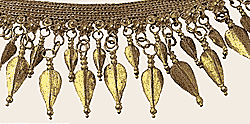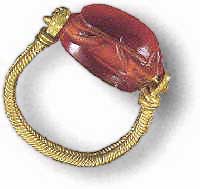  |

|

Detail of gold chain with dolphins
Fig 26 Gold chain with dolphin
terminals decorated with ivy leaves and enamel.
From Eretria 2nd century BC.
Athens, National
Archaeological Museum, XP 780.
|

|
|

Fig. 25 Detail of the gold necklace from Corinth.
Last quarter of
the 4th century BC.
Athens, National Archaeological Museum, XP 1050.
|

Fig 27 Gold ring.
325-300 BC.
Thessaloniki, Archaeological Museum,
Z9, Derveni, tomb Z.
|
|

Fig. 28 Gold ring with a sealstone.
325-300 BC.
Thessaloniki,
Archaeological Museum, Z11, Derveni, tomb Z.
|

Fig. 29 Gold hair ornament. Perhaps from
Thessaly.
200-150 BC.
Athens, National Archaeological Museum, ST. 369.
|
|

Fig 27 Gold ring.
325-300 BC.
Thessaloniki, Archaeological Museum,
Z9, Derveni, tomb Z.
|

Fig. 28 Gold ring with a sealstone.
325-300 BC.
Thessaloniki,
Archaeological Museum, Z11, Derveni, tomb Z.
|
Hellenistìc period
The great changes that mark the Hellenistic age (330-27 BC), initiated by the
conquests of Alexander the Great and increased contacts with the East and Egypt,
affected the art of jewellery too. Not only is the abundance of gold astonishing
but also the creation of new types of jewellery and the introduction of other
decorative themes. Polychromy (Fig.17) now came into its own, achieved by using
semi-precious and even precious stones, such as chalcedony, cornelian, amethyst
(fig.18), rock crystal and principally garnet (fig.19) -for less costly
jewellery glass paste was substituted-. New subjects appeared, remaining
well-established into Roman times, such as the Herakles knot (fig. 20), with its
apotropaic character, a borrowing from Egypt, as is the Isis crown which adorns
earrings from the second century B.C. Western Asia was the provenance of the
crescent (fig. 21), usually featuring as a necklace pendant. A purely Greek and
extremely popular motif espoused in this period was Eros (fig. 22). An important
type of earring appeared around 330 BC and predominated in Hellenistic and early
Roman times: the hoop with finial in the form of heads of animals, maenads,
negroes or of a full figure of Eros and other devices.
Widely disseminated at this time were the pendant earrings
(fig. 23) - the Eros, Nike, dove, amphora pendants embellished with gemstones or
enamel, hang from a rosette very often topped by the Isis crown. The necklaces
were either a broad strap chain from which hang fruits or calyxes (fig.24,25),
or a round chain with animal-head, dolphin terminals (fig. 26) etc. The rings
have bezels in diverse shapes (fig. 27), some set with sealstones (fig. 28) or
ordinary stones. Of the several types of bracelets, particularly interesting are
the snake-shape and those from Palaiokastro (fig.18) with cut-out vine leaves
and inlaid stones, enamel and the large amethyst on the clasp. A chef d'oeuvre
of this period is the medallion with bust of a goddess and a net of gold chains,
an ornament intended for female hairstyle (fig. 29).
The diadems comprise either a single strip with repousse
decoration and sometimes a pedimental finial at the centre, or a broad strap
with Herakles knot at the centre and pendants.The most elaborate are decorated
with floral patterns and an Eros at the center (fig. 22). The wreaths (fig.
30,31) consist of lavish foliage decoration with flowers, acorns, Erotes and
Nikes.
|
|


|
Greece jewellery pages Copyright ©
by Add
Information Systems. (Greece)
|
|
  |

